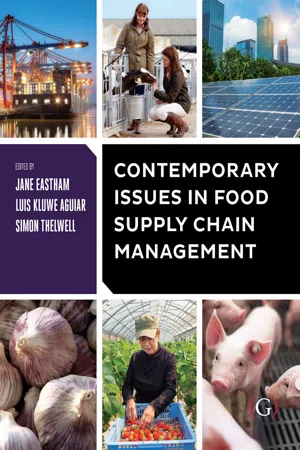
Contemporary Issues in Food Supply Chain Management
- 256 pages
- English
- PDF
- Available on iOS & Android
Contemporary Issues in Food Supply Chain Management
About This Book
This vital new text offers a holistic view of the factors affecting the different tiers of sustainability, public health, poverty, security and production within the food supply chain. With contributions from international experts in the field, it takes particular emphasis on growing populations and the deployment of agricultural land for uses other than food production.There are a growing number of key issues now facing the food agri-food and food industries, particularly in the light of growing populations and the deployment of agricultural land for uses other than food production e.g. biofuel. Contemporary Issues in the Food Supply Chain is the first text to provide a holistic overview covering topics such as: food security, sustainable intensification, obesity and food poverty, the environmental impact of the food supply chain, social and political climates and health.The text is divided into 3 key areas as follows: •The supply chain – problems and dilemmas including traceability, integrity, the changing consumer and food definitions.•Sustainable sourcing of food including food resources and human evolution, CSR, food security and alternative food production •Case studies and new areas of research including rural land use; carbon footprint; managing pathogens; Brexit as an opportunity for nutrition related health in agricultural policy.A must have text for academics, researchers, practitioners, policy makers and students in the fields of food management, agricultural and associated business courses.
Frequently asked questions
Information
Table of contents
- _GoBack
- Part 1
- The supply chain – problems and dilemmas
- Part 2
- Food security and sustainability
- Part 3
- Case studies and new areas of research
- Table 1.1: Types of format in the retail sector
- Table 1.2: The major UK retailers. Extracted from multiple IGD sources 2016
- Table 1.3: Retail pricing strategies
- Table 1.4: growth of specialist shops
- Table 1.5: Food service formats and segments
- Table 1.6: Food service formats and characteristics
- Figure 1.3: Market channels to food service and independent non mainstream retail
- Figure 2.1: Innovation and eco-innovation. Source: De Barcellos et al. (2015)
- Figure 2.2: Seuring and Müller’s (2008) model
- Figure 2.3: A model of sustainable supply chain management practices. Source: Pagell and Wu (2008)
- Figure 2.4: Range of Products. Source: Slovinscki Fotografia (2016)
- Figure 2.5: Eco-barrel building
- Figure 2.6: Econatura’s supply chain
- Figure 4.1: Supply chains
- Figure 5.1: Lgl extent of European ice cover and vegetation zones
- Figure 5.2: The Abri Blanchard calendar
- Figure 5.3: Hut reconstructions at Pushkari, Ukraine, showing the use of skins as durable coverings. By the author
- Figure 5.4: Hohlefels flute
- Figure 5.5: Middle Stone Age fish trap type as used in 21st century Vietnam.
- Figure 5.6: Afgan shepherds with sheep and goats, the Pastoral way of life. Photo by the author
- Figure 7.1: The food problem and classic food security model. Adapted from FAO (2009)
- Figure 8.1: The Long Island City rooftop farm, part of Brooklyn Grange Rooftop Farms, New York, USA (Image from www.brooklyngrangefarm.com).
- Figure 8.2: The world’s first commercial rooftop glasshouse, the Ahuntsic glasshouse, located in Montreal, Canada, operated by Lufa Farms Inc. (Image from lufa.com).
- Figure 8.3: Li Sun Exotic Mushrooms grow a wide variety of mushrooms in a railway tunnel in Mittagong, Australia (Image from www.li-sunexoticmushrooms.com.au).
- Figure 8.4: The vertical farming system of Sky Greens, located in Singapore, uses rotating stacked trays of plants to maximise light exposure (Image from skygreens.com).
- Figure 8.5: The GrowUp Urban Farms system combines an aquaponics system housed in a reused shipping container with a vertical farming setup above (Image from growup.org.uk).
- Figure 9.1: Schematic structure of nanoemulsion (A), solid lipid nanoparticle (B), micelle (C) and nanoliposome (D).
- Figure.9.2: Chemical structure of the β-cyclodextrin molecule (a) and the schematic illustration of drug-CD inclusion complex (1:1).
- Figure 12.1: The Global Goals. http://www.undp.org/content/undp/en/home/sustainable-development-goals.html
- Figure 13.2: Which groups caused the most problems. Source: Gilbert (2016)
- Figure 13.3: Reasons for visiting a Pick Your Own Farm. Source: Gilbert (2016)
- Figure 13.4: Strategies used to overcome impacts of poor weather by 60 PYO farms. Source: Gilbert (2016)
- Figure 13.5: Strategies used to reduce impact of theft Source: Gilbert (2016)
- 1 Defining Food and the Implications for Food Supply Chains
- 2 The Changing Consumer and the Emergence of Eco-consumption
- 3 Traceability: An Essential Mechanism to Underpin Food Integrity
- 4 Supply Chains and Horizontal and Vertical Integration: Coordination through the Food Industries